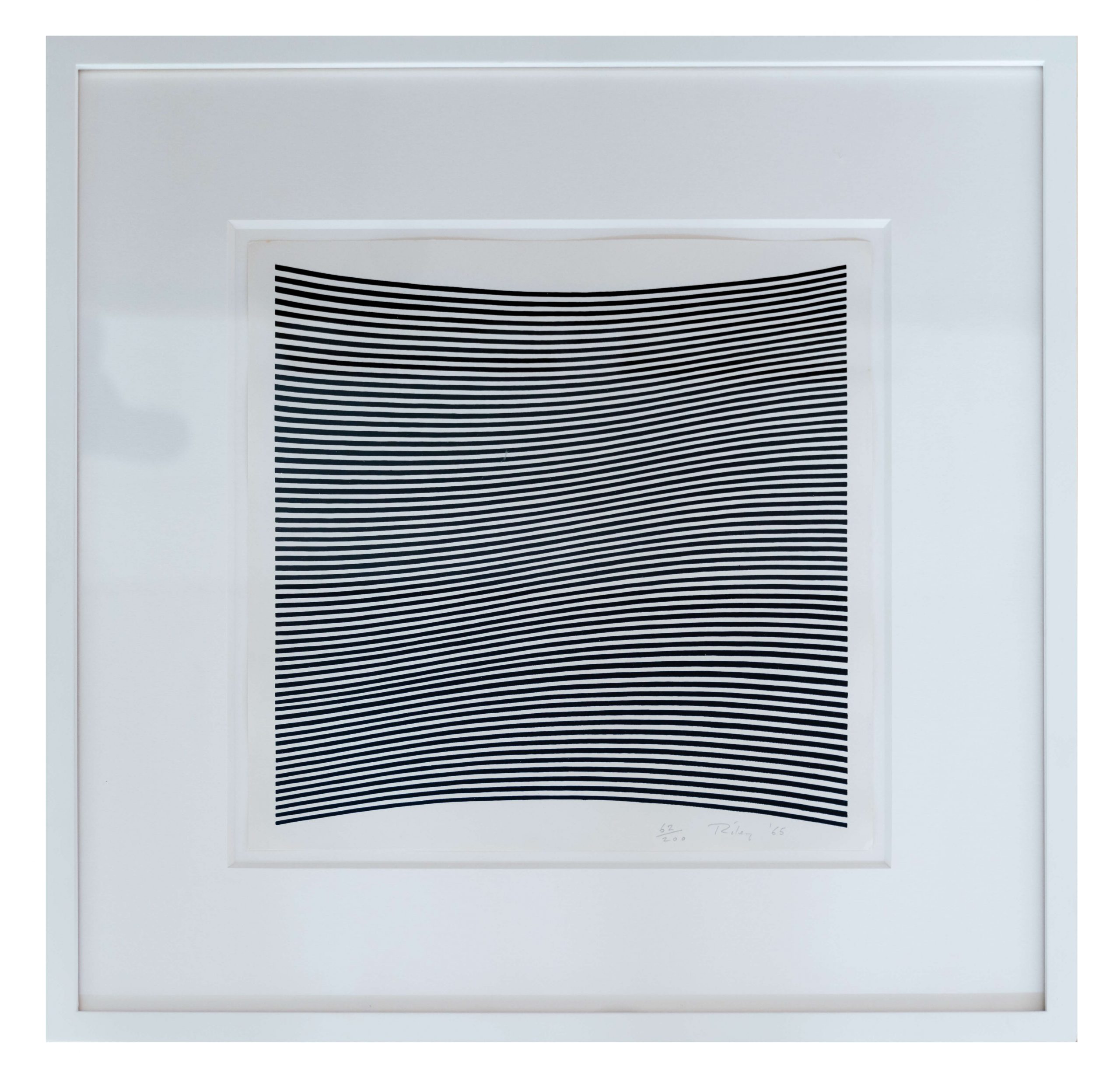Bridget Riley is a towering figure in the pantheon of 20th century contemporary art. A graduate of Goldsmiths College (Royal College of Art) England, Riley is best known for her invention of “Op Art” – a style of painting distinguished by pulsing, undulating lines that create a sense of optical illusion, re-examining historically referenced uses of linear perspective and composition.
After early forays into figurative and semi-Impressionistic work, Riley eventually found the way towards her mature, signature style via the work of Pointillist, Georges Seurat. Pointillism is an artistic technique in which tiny individual dots of color meld together to present a representative landscape. Yet- works in this style transcend the stasis of traditional landscape scenes- emanating movement and undulation. Seurat’s seminal influence on Riley is enormous.
Yet her genius was to take this technique a great leap forward, injecting the play between fore, middle and background, into geometric abstract work – in complementary colors – or in optical, waving lines of black and white.
Today Riley’s work is featured in the permanent collections of the world’s most renowned art museums including The Museum of Modern Art (New York); The Tate Gallery (London); The Fitzwilliam Museum (Cambridge, England); The Museum of Fine Art (Boston, Massachusetts) and The Nelson-Atkins Museum of Art (Kansas City, Kansas)- among others.
In 2022, Riley’s work Dabbles (1974), garnered the highest price for any woman artist at auction when it fetched $7.8m at a gala auction at Christie’s in London in 2022.
Riley has also been the recipient of numerous honors and accolades including the awarding of the Commander of the Most Excellent Order of the British Empire (CBE); the reception of honorary doctorates from both Oxford and Cambridge Universities; and (in 1998) she became only one of sixty-five recipients of the Companions of Honor in Britain.
Riley’s bold abstract, color-field compositions and her signature black and white pulsing Op-Art works have, over time, become inextricably linked to the shifting cultural consciousness afoot in London in the “Swinging 60s – a period in which England, fatigued by post-war austerity and economic hardship, undergoing a cultural and societal paradigm shift. It was a decade in which a wave of primarily young people began a movement insisting on more liberated ways thinking and living, and the movement dovetailed with the challenging of traditional roles of women in society.
Superficially it is easy, if not lazy, to marry Riley’s art to the aesthetic manifestations of this era. In a facile way, one could fold them aesthetically into the canon of explosive, psychedelic graphics and fashion designs that organically erupted during the period. And it is even more tempting to adopt Riley – an independent, avant-garde artist of immense talent – as a mouthpiece for the women’s liberation movement.
Yet Riley herself has shut down these comparisons. She has remained adamant throughout her extensive career that she is opposed to the co-opting of her work in the name of a “cause” – or towards the furthering of any political agendas.
In short, Riley is an artistic purist and an academic. She is concerned with her work; her concerns internal, not external, and she has been disciplined in her insistence that her work be judged outside of any cultural or historical context. As she characteristically and succinctly stated: “While one must accept that art and its subjects do change, the practical problems do not. How to treat color? Pictorial space? Structure, etc.?
Controversially, Riley has also been consistently vocal, expressing her wish that she is not dubbed a: “feminist artist.” This proclamation has been a difficult point of contention with other women artists – who feel that her prestige could have leant importance to the grievances of other female artists and who have felt frustratingly marginalized in a still male-dominated art world. And finally, also true to form, she has railed in disgust at times, about the commercialism and superficiality of the art world.
After the excitement generated by her first, and critically acclaimed exhibition in 1965, The Responsive Eye at New York’s Museum of Modern Art in 1967, Riley was appalled at the media frenzy it sparked. She stated at the time: “Its qualities were obscured by an explosion of commercialism, band-wagoning and hysterical sensationalism. It left me feeling violated and suffused with disillusionment.”
Visit The Foundation
If you are interested in visiting the RAK foundation and its collection, we would be happy to show you around. Contact us for more information.
